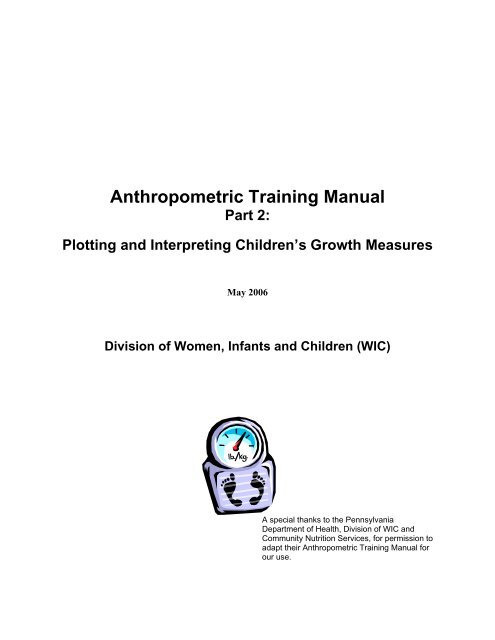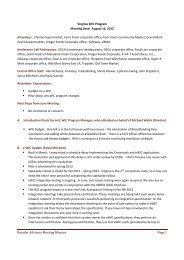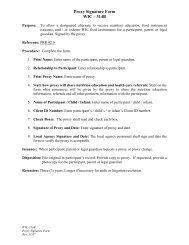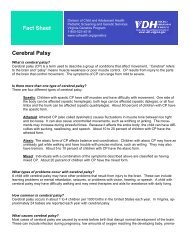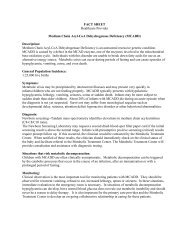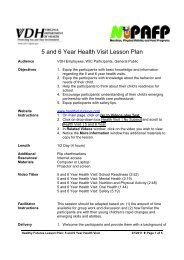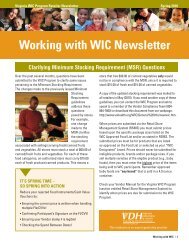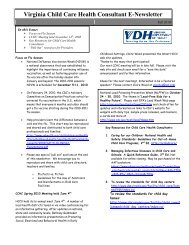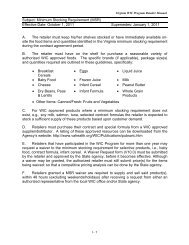Anthropometric Training Manual Part 2: Plotting and Interpreting ...
Anthropometric Training Manual Part 2: Plotting and Interpreting ...
Anthropometric Training Manual Part 2: Plotting and Interpreting ...
Create successful ePaper yourself
Turn your PDF publications into a flip-book with our unique Google optimized e-Paper software.
<strong>Anthropometric</strong> <strong>Training</strong> <strong>Manual</strong><strong>Part</strong> 2:<strong>Plotting</strong> <strong>and</strong> <strong>Interpreting</strong> Children’s Growth MeasuresMay 2006Division of Women, Infants <strong>and</strong> Children (WIC)A special thanks to the PennsylvaniaDepartment of Health, Division of WIC <strong>and</strong>Community Nutrition Services, for permission toadapt their <strong>Anthropometric</strong> <strong>Training</strong> <strong>Manual</strong> forour use.
Table of Contents<strong>Plotting</strong> Children’s Growth Measurements, Learner Objectives........................2Growth Charts.....................................................................................................3Growth Percentiles..............................................................................................6Learning Exercises on <strong>Manual</strong>ly <strong>Plotting</strong> Growth Measurements......................9Learning Exercises on <strong>Manual</strong>ly <strong>Plotting</strong> Growth Measurements- Answers....10Monitoring Growth Patterns...............................................................................13<strong>Interpreting</strong> Growth Patterns- Practice Exercises...............................................15<strong>Interpreting</strong> Growth Patterns- Practice Exercises- Answers...............................261
Growth ChartsPurpose of growth chartsBy plotting a child’s growth over time, WIC staff can screen for potential growth problems, makereferrals <strong>and</strong> provide nutrition counseling as appropriate.How to plot the growth charts manuallyNormally, the data system will plot the growth charts for you based on the child’s sex, birth date <strong>and</strong>current measurements. Note: If the values you input are in error, the growth plots will be also!If the WIC data system is down, you will need to know how to plot growth charts manually.<strong>Plotting</strong> length/age, weight/age, <strong>and</strong> head/age on the 0-36 months chartsFirst, calculate the child’s age by subtracting the child's date of birth from the date of measurement.Example 1:Date of Measurement: April 15, 2005Child's Date of Birth: January 10, 2005Year Month DayDate of Measurement 2005 4 15Date of Birth 2005 1 10Age . 3 mo. 5 daysExample 2You may need to borrow 30 days from the month column <strong>and</strong>/or 12 months from theyear column.Date of measurement: April 15, 2005Child's Date of Birth: October 26, 2002Year Month DaysDate of Measurement 2005 (2004) 4 (15) 15 (45)Date of Birth 2002 10 26Age 2 yrs. 5 mo. 19 daysLocate the child’s age on the horizontal axis of the length/age, weight /age, or head/age grid.(The chart is calibrated to the nearest half month.) Locate the child’s length, weight or headcircumference on the vertical axis of the grid. Plot the point where these two values intersect.Note: Use adjusted age to plot weight/age, length/age <strong>and</strong> head/age for premature infants <strong>and</strong> childrenless than 2. Adjusted age is the actual age minus the number of weeks or months premature. Example:What is the adjusted age of a 7 week baby born at 36 wks gestation (4 wks early)?7 wks (actual age) minus 4 wks (# wks premature) = 3 wks Adjusted Age3
<strong>Plotting</strong> the weight/length on the 0-36 months growth chartFind the infant/child’s length on the horizontal axis <strong>and</strong> the weight on the vertical axis. Findthe point where these two values intersect.<strong>Plotting</strong> height/age <strong>and</strong> weight/age on the 2 - 5 or 2 – 20 growth chartsCalculate the child’s age as instructed on page 3.If using the 2-5 years chart, plot to the nearest month. On the 2-20 years chart, you must firstround the months to the nearest ‘quarter year’ using the following guide:0-1 month: nearest year (4 years 1 month would be 4 years.)2-4 months: ¼ year (4 years 3 months would be 4 ¼ years)5-7 months: ½ year (4 years 7 months would be 4 ½ years)8-10 months: ¾ year (4 years 10 months would be 4 ¾ years)11-12 months: next year (4 years 11 months would be 5 years)Locate the child’s age in years on the horizontal axis of the grid <strong>and</strong> the child’s height or weighton the vertical axis of the grid. Plot the point where these two values intersect<strong>Plotting</strong> the BMI on the 2-20 year growth chartNormally the data system will calculate BMI for you. It the system is down, you can use thefollowing equations:English system:BMI = Weight in pounds ÷ height in inches ÷ height in inches x 703Note: fractions <strong>and</strong> ounces must be entered as decimal points.Fraction Ounces Decimal1/8 2 .1251/4 4 .253/8 6 .3751/2 8 .55/8 10 .6253/4 12 .757/8 14 .875Example: A 33 pound 4 ounce child is 37 5/8 inches tall.BMI = 33.25 ÷ 37.625 ÷ 37.625 x 703 = 16.5Metric System:BMI = Weight in kilograms ÷ height in centimeters ÷ height in centimeters x 10,000Example: A 16.9 kg. child is 105.2 cm tall.4
BMI = 16.9 ÷ 105.2 ÷ 105.2 x 10,000 = 15.3Locate the BMI value on the vertical axis <strong>and</strong> the child’s age on the horizontal axis. Find where thosetwo intersect on the grid.Note: CDC also has an extended BMI table that you may print off the internet <strong>and</strong> keep at your desk forreference in the event that the data system is down: WWW.CDC.gov/growthcharts5
Growth PercentilesA child’s growth plots will fall on or between a percentile line. These lines (or growth curves) range fromthe 97 th to the 3 rd percentile. The percentile ranking compares a child's height, weight, head circumfernce<strong>and</strong> BMI (Body Mass Index) to other children in the United States who are the same age <strong>and</strong> sex.The 50 th percentile represents the ‘midpoint’ of the range. Greater than the 50th percentile represents thehigher end of the range <strong>and</strong> less than the 50 th , the lower end of the range.Height/Age, Weight/Age, Head Circumference/Age <strong>and</strong> Weight/Height percentilesYou can interpret the percentiles on these growth charts as follows:• If the child's height for age plots at the 50th percentile, it means that 50 out of 100 children of thesame sex <strong>and</strong> age would be taller <strong>and</strong> 50 would be shorter.• If a child's height for age plots at the 25th percentile, it means 75 out of 100 children of the same sex<strong>and</strong> age would be taller <strong>and</strong> 25 would shorter.• If a child's weight for age plots at the 75th percentile, it means 75 out of 100 children of the same sex<strong>and</strong> age would weigh less <strong>and</strong> 25 would weigh more.• If a child’s weight/height plots at the 95%, it means that 5 out of 100 children of the same height <strong>and</strong>sex would be heavier <strong>and</strong> 95 would be lighter.• If a child’s head circumference plots at the 90%, it means that 10 out of 100 children of the same sex<strong>and</strong> age would have a larger head circumference <strong>and</strong> 90 children, smaller.The growth curves for the height/age, weight/age, <strong>and</strong> weight/height follow a steady upward trend as ageincreases.Note: It is not necessary to explain every percentile reading to participants. You shouldinterpret all growth plots, focusing on progression of growth, but you may summarize yourfindings with the participant. For example, when appropriate you may say “your child isgrowing well”, or “your child didn’t gain much weight in the past 6 months”, etc.BMI percentilesBMI (Body Mass Index) is a number value that is calculated from the child’s height <strong>and</strong> weight. BMIprovides an estimate of the amount of body fat in children between the ages of 2-20. Usually, the lowerthe BMI, the leaner the child. A high BMI is generally associated with a higher proportion of body fat.(However, those with a higher proportion of muscle mass may also have a higher BMI. This is not likelyduring the pre-school years.)6
Learning Exercises on <strong>Manual</strong>ly <strong>Plotting</strong> Growth Measurements1. Gregory was born on November 14, 2004. Today's date is April 15, 2005.His weight is 12 pounds <strong>and</strong> his length is 25 inches. His head circumference is16 ½ inches.How old is Gregory?___________________________What are his growth percentiles for:length for age ___________________________weight for age ___________________________Wt./length___________________________head circumference___________________________What is Gregory's WIC nutritional risk criteria? ____________2. Tom was born March 21, 2001. He was measured March 19, 2005.His height was 42 ½ inches <strong>and</strong> his weight was 47 pounds.How old is Tom?What is Tom’s BMI?_____________________________________________________What are his growth percentiles for:height for age ___________________________weight for age ___________________________BMI/age___________________________What is Tom’s nutritional risk? ____________________3. Jane was born on February 3, 2003. Today's date is April 30, 2005.Her st<strong>and</strong>ing height is 32 inches <strong>and</strong> her weight is 25 pounds.How old is Jane?___________________________Which chart should you use to plot her measurements? _______________________What are her percentiles for:Wt/Age ______Ht/Age ______BMI ______9
Learning Exercises on <strong>Manual</strong>ly <strong>Plotting</strong> Growth Measurements--Answers1. Gregory was born on November 14, 2004. Today's date is April 15, 2005.His weight is 12 pounds <strong>and</strong> his length is 25 inches. His head circumference is 16 ½ inches.How old is Gregory?5 months, 1 dayWhat are his growth percentiles for:length for ageweight for ageweight for lengthhead circumference25th
Monitoring growth patterns<strong>Plotting</strong> a single set of measurements on a growth chart only compares a child to other children. It willnot tell you if the child’s growth rate is normal for that child. Even though a plot may fall within normallimits, it may not be ‘normal’ for that particular child when compared to his/her previous plots ormeasurements.To evaluate growth, you must look at the child’s progression of growth over time. A large drop orincrease in percentile channel, fluctuations in weight or inadequate gains in height or weight mayindicate potential problems.The following are examples of growth patterns that may require further follow-up or referral.Monitoring Growth Curves/MeasurementsInterpretation1-2 percentile curve drop* in Wt./Age or… May be normal growth pattern.***Inadequate weight gain between certs.May be due to inadequate food intake, illness,May be eligible for Nutrition Risk DF.or dehydration.See back of assessment form.Evaluate diet. Refer to MD if necessary.1-2 percentile curve drop* in Ht./Age May be normal growth pattern*** or inaccuratemeasurements. May be due to disease orchronic malnutrition.Evaluate diet. Recheck measurements. Refer toMD if necessary.1-2 percentile curve drop* in BMI/age May be due to poor nutrition, dehydration, oror Wt/Ht.illness.1-2 percentile curve gain* in BMI/age May be gaining weight disproportionately. Anor Wt/Ht.upward trend in BMI prior to age of 4 mayindicate that the child is at higher risk forbecoming obese later in life.Note: May also be recovering fromundernutrition or an illness.*Note: The drop or gain refers to a shift between the major percentile curves, not a shift of one to twopercent. (For example, a shift from the 50 th to the 10 th %ile, not the 50 th to the 48 th %ile)***Note: Any weight loss in infants (after first few days of life) or young children is not normal.However, it may be normal for children less than 24 months to gradually shift percentiles upward ordownward toward their ‘genetic potential.’ Most healthy children shift toward rather than away from the50 th %ile. Do not assume any shifts are normal without first evaluating diet, activity, overall health, etc.13
Special Notes on Assessing Growth of New InfantsWhen assessing growth of new infants, it is important to look at weight gain in ounces inaddition to looking at the growth percentiles:• Infants may lose about 6 % of birth weight during the first few days of life.o A loss of greater than or equal to either 8% or 8 oz should be evaluated <strong>and</strong>referred to a physician.• Infants should begin regaining any weight lost by day 5 – 7.o Ask caregiver about hospital discharge weight <strong>and</strong> compare to current weight tomake sure baby is beginning to regain any weight lost.• Infants are usually back to birth weight by 10 -14 days, <strong>and</strong> gain about 5 -7 oz/wk duringthe first 4 - 6 months of life. They should double birth weight by 4 – 6 months <strong>and</strong> tripleit by one year.• Infant birth length measures may be inaccurate or distorted due to birth trauma, solength/age <strong>and</strong> wt/length of new infants may be inaccurate. Be sure to also look atprogression of weight/age.Note: New infants should be weighed in dry diaper only (unless the room is very cold) to ensureaccurate assessment of weight gain. Even light outer clothing can add ounces that make adifference in small infants.14
<strong>Interpreting</strong> Growth Patterns—Practice ExercisesCase Study 1: AshleyHow would you interpret Ashley’s weight/age <strong>and</strong> height/age?How would you interpret Ashley’s BMI?Overall, how would you describe Ashley’s growth? What issues would you evaluate that mightbe impacting Ashley’s growth?Case Study 2: AntonHow would you interpret Anton’s weight/age <strong>and</strong> length/age?How would you interpret Anton’s weight/length?Overall, how would you describe Anton’s growth? What issues would you evaluate that mightbe impacting Anton’s growth?Case Study 3: MariaHow would you interpret Maria’s weight/age <strong>and</strong> length/age?Has Maria gained adequate weight since birth?How would you interpret Maria’s weight/length?Overall, How would you describe Maria’s growth?15
`19
<strong>Interpreting</strong> Growth—Practice Exercises AnswersCase Study 1: AshleyHow would you interpret Ashley’s weight/age <strong>and</strong> height/age?• Weight/age is slowly rising. Height/age progressing smoothly slightly above the 25%ile.How would you interpret Ashley’s BMI/age?• BMI/age seems to be rising rapidly <strong>and</strong> is now at the 95%ile.Overall, how would you describe Ashley’s growth? What issues would you evaluate that mightbe impacting Ashley’s growth?• She is gaining weight rapidly <strong>and</strong> could remain overweight later in life if rapid gain continues.(Use your discretion as to whether to explain this to a parent who may be sensitive). Evaluateeating habits <strong>and</strong> physical activity <strong>and</strong> focus on improving these practices rather than focusing onweight gain.Case Study 2: AntonHow would you interpret Anton’s weight/age <strong>and</strong> length/age?• Weight/age <strong>and</strong> length/age are progressing smoothly at approximately 5%ileHow would you interpret Anton’s weight/length?• Weight/length is progressing smoothly just below the 50%ile.Overall, how would you describe Anton’s growth? What issues would you evalutate that mightbe impacting Anton’s growth.• He is small, but his weight <strong>and</strong> height are proportional <strong>and</strong> he seems to be growing well.Evaluate birth weight, size of parents, feeding practices, <strong>and</strong> medical history.Case Study 3: MariaHow would you interpret Maria’s weight/age <strong>and</strong> length/age?• Weight/age is progressing smoothly around the 50%ile. Length/age is seems to be dropping, butthis is probably due to inaccurate or distorted birth measures.Has Maria gained adequate weight since birth?• Maria gained about 12 ounces in the 16 days since birth. Her weight gain is good (See page 14about weight gain for newborns).How would you interpret Maria’s weight/length?• Although weight/length appears to be dropping, actually the higher plot is the more recent plot.Birth weight/length was probably inaccurate because the birth length was inaccurate or distorted.Overall, How would you describe Maria’s growth?• She seems gaining weight well.26


